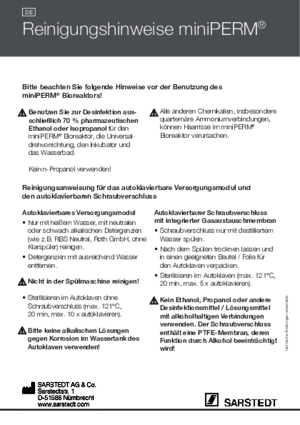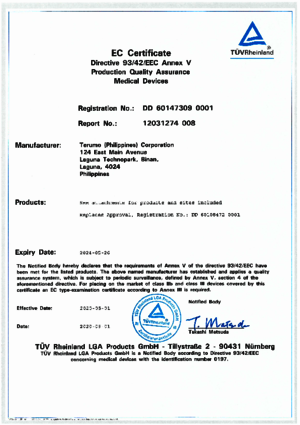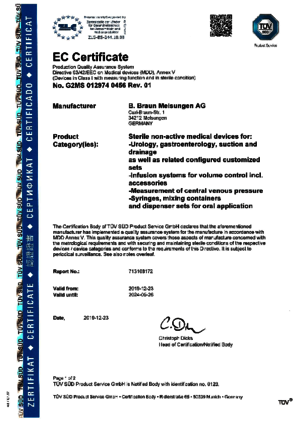
Cell- and tissue culture
Cell- and tissue culture
Language:
miniPERM® is an easy-to-use bioreactor for the cultivation of eukaryotic cells in high densities. The sub-division of the bioreactor into production and nutrient modules and the rotating cultivation allow for the production of highly concentrated cell products in small volumes. This means that the miniPERM® bioreactor is a cost-effective and time-saving alternative to conventional tissue and roller bottles and to fermentation systems.

miniPERM®, Start-up support kit, accessories for inoculation, sample collection and harvesting, for miniPERM® bioreactor, not autoclavable, set components: 8 x disposable syringe 50 ml, 20 x disposable syringe 2 ml, 8 x filling tube, 20 x needle, 6 x septum cap, 1 x miniPERM® stand, 1 piece(s)/bag

miniPERM®, classic bioreactor, 2-compartment bioreactor, for protein, virus and biomass production, for suspension cells, volume of product module: 35 ml, not autoclavable, sterile, non-pyrogenic/endotoxin-free, non-cytotoxic, 1 piece(s)/bag

miniPERM®, classic production module, Tissue culture compartment, for protein, virus and biomass production, for suspension cells, volume of product module: 35 ml, not autoclavable, sterile, non-pyrogenic/endotoxin-free, non-cytotoxic, 1 piece(s)/bag

miniPERM®, HDC 50 bioreactor, 2-compartment bioreactor, for protein, virus and biomass production, for suspension cells, volume of product module: 50 ml, not autoclavable, sterile, non-pyrogenic/endotoxin-free, non-cytotoxic, 1 piece(s)/bag
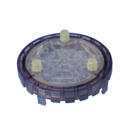
miniPERM®, HDC 50 production module, Tissue culture compartment, for protein, virus and biomass production, for suspension cells, volume of product module: 50 ml, not autoclavable, sterile, non-pyrogenic/endotoxin-free, non-cytotoxic, 1 piece(s)/bag

miniPERM®, Nutrient module, for miniPERM® production module, autoclavable up to 121 °C, non-pyrogenic/endotoxin-free, non-cytotoxic, 1 piece(s)/bag

miniPERM®, Rack, for miniPERM® bioreactor, not autoclavable, 4 piece(s)/case

miniPERM®, Screw cap, for miniPERM® production module, not autoclavable, sterile, non-pyrogenic/endotoxin-free, non-cytotoxic, 1 piece(s)/blister

miniPERM®, Screw cap, for miniPERM® nutrient module, not autoclavable, sterile, non-pyrogenic/endotoxin-free, non-cytotoxic, 1 piece(s)/blister
miniPERM®, Luer cannula, for miniPERM® bioreactor, Luer (f), not autoclavable, sterile, non-pyrogenic/endotoxin-free, 1 piece(s)/blister
miniPERM®, Disposable syringe 2 ml, for miniPERM® bioreactor, Luer, not autoclavable, sterile, 1 piece(s)/blister
miniPERM®, Disposable syringe 50 ml, for miniPERM® bioreactor, Luer lock, not autoclavable, sterile, 1 piece(s)/blister

miniPERM®, Filling tube 5'', for miniPERM® bioreactor, not autoclavable, sterile, 1 piece(s)/blister
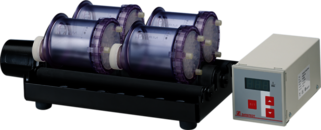
Universal turning device, for 4 miniPERM® bioreactors, not autoclavable, 115/230 V, 1 piece(s)/case



The miniPERM® is an easy-to-handle bioreactor which was developed for the cultivation of eukaryotic cells such as mammal cells, insect cells and plant cells in high density and therefore for biomass production and for the production of cell products. The sub-division of the bioreactor into production and nutrient modules and the rotating cultivation allow for the production of highly concentrated cell products in small volumes. Therefore, depending on the cell line, cell densities of more than 107 cells/ml and product concentrations of several mg/ml can be achieved. This means that the miniPERM® bioreactor is a cost-effective and time-saving alternative to conventional tissue and roller bottles and to fermentation systems.
The production module of the miniPERM® bioreactor is available for suspension cells in volumes of 35 ml or 50 ml. We offer a production module with a stationary matrix for adherent cells.
The miniPERM® bioreactor is subdivided into a production module and a nutrient module (two-compartment system) by a dialysis membrane. The dialysis membrane has a cut-off size of 12.5 kDa, so that that neither cells nor secreted cell products can diffuse into the nutrient module. At the same time, however, the exchange of nutrients and cell metabolites takes place via the dialysis membrane.
We would like to show you additional content which is hosted by a third party. For this purpose we need your consent to set cookies:

